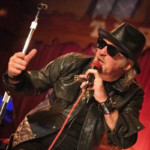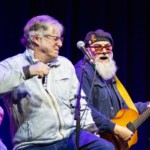It was just the beginning of the day, only eleven in the morning, and already thick crowds were bustling down Gentilly Road, one of a few streets that lead to a festival entrance. The smell of sunscreen wafted through the air, followed by pink faces, Hawaiian shirts or Jazz Fest shirts from previous years, hats and an assortment of colored chairs, strapped to the backs of determined and loyal Jazz Festers. The sidewalks were confettied with vendors of all sorts, from neighborhood people selling festival swag and necessities to, every few feet, kids with coolers selling bottles of cold water.
Upon entering the festival, folks were greeted with the tantalizing aroma of New Orleans cuisine billowing from the strips of food tents, already creating a conflict of priority: food or music? Horns, drums, guitars, bass and all different musical sounds were searching for us from every direction immediately confronting us with decisions to make. Festival goers have several different plans of attack (i.e. Plans of how to accommodate the schedule to suit their needs and wants). Personally, I have always previewed the line-up/schedule in advance and planned a loose but scheduled musical itinerary. Though I’ve envied the single-stage dwellers at times, I have never been willing to endure the sacrifice it would require to camp out at one stage. While running from stage to stage all day can be rather exhausting, as most Jazz Fest vets can agree, it’s far more daunting to consider all the great music you miss by committing to only one stage.
While many are drawn in by the headliners, the true gems are at the smaller stages and tents, where you’ll find artists showcased that are far more reminiscent of New Orleans music and heritage– the original concept of the festival. At first, I veered towards the area where the Blues Tent, Jazz Tent and Gospel Tent stood in a row. I stumbled into the Gospel Tent to discover Leo Jackson & the Melody Clouds, who sang and danced as though it would save lives. Another highlight of the day included– but was certainly not limited to– the Semolian Warriors Mardis Gras Indians at the Jazz Heritage Stage, adorned in vibrant colors and spectacularly detailed costumes, stitched with sequins and patterns, dancing collectively on stage. I was later enchanted into the Jazz Tent by the Nicholas Payton Trio with Vicente Archer and Bill Stewart.
Unfortunately, yet not out of character for New Orleans nor Jazz Fest, the skies darkened and the wind began to pick up, strongly suggesting the imminent threat of a storm to come… which of course meant plenty of rain and mud to follow. Festivalgoers lucked out, and the storm didn’t strike until the very end of the day, just into the second half of Wilco’s set, the last scheduled for the Gentilly Stage that day. Tweedy, upon walking onstage and approaching his microphone, had a look of amusement and uncertainty. Perhaps he was amused by the size of the crowd, ever so willing to endure whatever was to come in order hear him and his band play. Perhaps he was himself uncertain if he would even play, or for how long considering the looming darkness that cloaked the stage. Yet, moments later the sound of the electric guitar and the hum of the rest of the band seamlessly roared into their first song, “Handshake Drugs,” and heads swayed along. They continued on, and graciously played songs from an assortment of their albums, which is always appreciated for true fans. After a long, exhausting, music-filled day, I stayed for half of the set, but was urged by the clouds to leave sooner rather than later.
– Alicia Gallagher
Photos by Kyra Kverno






Be the first to comment!